Energy-Aware Task Allocation for Multi-Cloud Networks
Smart algorithm to optimize performance of the heterogeneous multi-cloud network
 Dr Sambit Kumar Mishra
Dr Sambit Kumar Mishra
As the world goes more digital in the future, the dependability on cloud computing is going to be more. The availability of high-capacity networks, low-cost computers and storage devices as well as the widespread adoption of hardware virtualization, service-oriented architecture and autonomic and utility computing has led to growth in cloud computing. But is it enough? How to improve its performance? How to make it more reliable with high-end technology and impeccable performance quality? Dr Sambit Kumar Mishra’s research has an answer to that.
 System Model for Multi-cloud Networks Dr Sambit Kumar Mishra, Assistant Professor, Computer Science and Engineering has published a paper “Energy-Aware Task Allocation for Multi-Cloud Networks” in renowned journal IEEE ACCESS with an Impact Factor: 3.745. The research was done in collaboration with Dr Sonali Mishra, SOA (Deemed to be) University Bhubaneswar, India; Dr Ahmed Alsayat, College of Computer and Information Sciences Jouf University, Al-Jouf, Saudi Arabia; Dr N Z Jhanjhi and Dr Mamoona Humayun, School of Computer Science and Engineering (SCE), Taylor’s University, Malaysia; Dr Ashish Kr. Luhach, The PNG University of Technology, Papua New Guinea Lae, Morobe; Dr Kshira Sagar Sahoo, VNRVJIET, Hyderabad, India.
System Model for Multi-cloud Networks Dr Sambit Kumar Mishra, Assistant Professor, Computer Science and Engineering has published a paper “Energy-Aware Task Allocation for Multi-Cloud Networks” in renowned journal IEEE ACCESS with an Impact Factor: 3.745. The research was done in collaboration with Dr Sonali Mishra, SOA (Deemed to be) University Bhubaneswar, India; Dr Ahmed Alsayat, College of Computer and Information Sciences Jouf University, Al-Jouf, Saudi Arabia; Dr N Z Jhanjhi and Dr Mamoona Humayun, School of Computer Science and Engineering (SCE), Taylor’s University, Malaysia; Dr Ashish Kr. Luhach, The PNG University of Technology, Papua New Guinea Lae, Morobe; Dr Kshira Sagar Sahoo, VNRVJIET, Hyderabad, India.
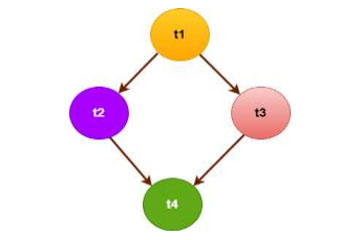 Example of Direct Acyclic Graph (DAG)with four TasksIn recent years, the growth rate of Cloud computing technology is exponentially, mainly for its extraordinary services with expanding computation power, the possibility of massive storage and all other services with the maintained quality of services (QoS). The task allocation is one of the best solutions to improve different performance parameters in the cloud, but when multiple heterogeneous clouds come into the picture, the allocation problem becomes more challenging. This research work proposed a resource-based task allocation algorithm. The same is implemented and analysed to understand the improved performance of the heterogeneous multi-cloud network. The proposed task allocation algorithm (Energy-aware Task Allocation in Multi-Cloud Networks (ETAMCN)) minimizes the overall energy consumption and also reduces the makespan. The results show that the makespan is approximately overlapped for different tasks and does not show a significant difference. However, the average energy consumption improved through ETAMCN is approximately 14%, 6.3%, and 2.8% in opposed to the random allocation algorithm, Cloud Z-Score Normalization (CZSN) algorithm, and multi-objective scheduling algorithm with Fuzzy resource utilization (FR-MOS), respectively. An observation of the average SLA-violation of ETAMCN for different scenarios is performed.
Example of Direct Acyclic Graph (DAG)with four TasksIn recent years, the growth rate of Cloud computing technology is exponentially, mainly for its extraordinary services with expanding computation power, the possibility of massive storage and all other services with the maintained quality of services (QoS). The task allocation is one of the best solutions to improve different performance parameters in the cloud, but when multiple heterogeneous clouds come into the picture, the allocation problem becomes more challenging. This research work proposed a resource-based task allocation algorithm. The same is implemented and analysed to understand the improved performance of the heterogeneous multi-cloud network. The proposed task allocation algorithm (Energy-aware Task Allocation in Multi-Cloud Networks (ETAMCN)) minimizes the overall energy consumption and also reduces the makespan. The results show that the makespan is approximately overlapped for different tasks and does not show a significant difference. However, the average energy consumption improved through ETAMCN is approximately 14%, 6.3%, and 2.8% in opposed to the random allocation algorithm, Cloud Z-Score Normalization (CZSN) algorithm, and multi-objective scheduling algorithm with Fuzzy resource utilization (FR-MOS), respectively. An observation of the average SLA-violation of ETAMCN for different scenarios is performed.
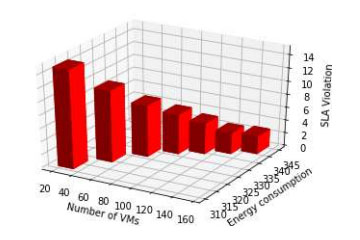 Energy Consumption Vs SLA Violation when
Energy Consumption Vs SLA Violation when
the number of VMs varies and the number of Task is 100.The multi-cloud strategy offers flexibility to service providers. It allows businesses to be productive while using the proper set of services to optimize their opportunities. Adopting a multi-cloud network enables an enterprise to implement a “best of breed” model for the services. Organizations’ ability to choose the vendor that offers the best price for their workload is added significant advantage of multi-cloud. Thus, the optimization of energy consumption in a multi-cloud environment is necessary for the current generation.
However, this proposed work has not considered any priority-oriented users, such as task execution through reserve resource in the network, which will be considered as his future work. The future work also aims to propose a task cum resource-aware scheduling approach that will exploit the nature of the presented workload and efficiently map on the available Cloud resources so that energy consumption will optimize.
Link to the research paper: Please Click Here
- Published in CSE NEWS, Departmental News, News, Research News
Dr Writoban Basu Ball receives an outlay of Rs. 26.34 lakhs from DST, Government of India
Pursuit of discovering new drug molecules to combat diseases
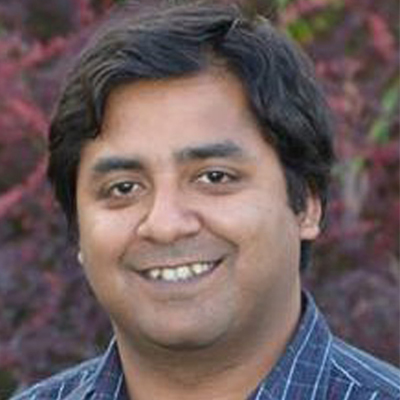
Dr Writoban Basu Ball, Assistant Professor, Department of Biological Sciences, received an outlay of Rs.26.34 lakhs from DBT, Government of India to pursue research on “Targeting Kennedy pathway of cellular phosphatidylethanolamine biosynthesis as a common therapeutic strategy against protozoan parasites like Leishmania donovani, Trypanosoma brucei and Entamoeba histolytica.” Disease-causing intracellular parasites present serious health challenges, which could be fatal if left untreated. For example, Leishmania donovani and Trypanosoma brucei are the causative agents of visceral leishmaniasis and sleeping sickness, respectively. Entamoeba histolytica causes amoebiasis and 100,000 people die each year world-wide from amoebiasis-related complications. The current treatment regimen against these diseases consists of drugs that possess severe toxicity and drug resistance. Toxicity is detrimental to health and drug-resistance causes unresponsiveness of the drug to the parasite, rendering the drug ineffective. Therefore, it has become imperative to discover new drug molecules to combat these diseases.
 In his study, Dr Writoban proposes to repurpose an FDA-approved drug meclizine, which can be used as a potential drug against dreadful parasitic infections. He explains. “One rational way to discover new and effective drugs entails identifying pharmacological targets against unique yet essential parasite metabolic pathways which are either absent or redundant in hosts (in the present case humans). One such central metabolic pathway in L. donovani, T. brucei, and E. histolytica is the Kennedy pathway for the biosynthesis of phosphatidylethanolamine (PE), a major lipid molecule of the cell. Without the presence of this lipid molecule, the cellular membranes (plasma membrane, organellar membranes) cannot form. Therefore, the Kennedy pathway is indispensable to parasite survival. On the contrary, in humans, although the Kennedy pathway is present, other pathway of PE biosynthesis is predominant. Hence, the Kennedy pathway offers a potential target to disrupt PE biosynthesis in these parasites without causing any side effects in the human host. In this context, meclizine, an over the counter anti-nausea drug, has been shown to disrupt the Kennedy pathway.”
In his study, Dr Writoban proposes to repurpose an FDA-approved drug meclizine, which can be used as a potential drug against dreadful parasitic infections. He explains. “One rational way to discover new and effective drugs entails identifying pharmacological targets against unique yet essential parasite metabolic pathways which are either absent or redundant in hosts (in the present case humans). One such central metabolic pathway in L. donovani, T. brucei, and E. histolytica is the Kennedy pathway for the biosynthesis of phosphatidylethanolamine (PE), a major lipid molecule of the cell. Without the presence of this lipid molecule, the cellular membranes (plasma membrane, organellar membranes) cannot form. Therefore, the Kennedy pathway is indispensable to parasite survival. On the contrary, in humans, although the Kennedy pathway is present, other pathway of PE biosynthesis is predominant. Hence, the Kennedy pathway offers a potential target to disrupt PE biosynthesis in these parasites without causing any side effects in the human host. In this context, meclizine, an over the counter anti-nausea drug, has been shown to disrupt the Kennedy pathway.”
Dr Writoban’s research is oriented to find safe cures for dreadful parasitic diseases that mostly plagues the underprivileged section of the developing countries like India, and countries of the sub-Saharan Africa. He believes, “The successful implementation of the proposed research scheme would benefit a lot of underprivileged people belonging to the underdeveloped and developing countries, as well as reduce the disease burden of those countries.” Further, Dr Writoban emphasizes, “Getting the grant is only the job half done. I would like to guide this proposal to a fruitful completion so that it can benefit people who need it most. I really want to take this project beyond the bounds of a mere academic exercise.
- Published in News, Research News
DST, Government of India sanctions an outlay of Rs.14.63 lakhs to Dr Tapan Kumar Hota
Connecting the dots between Mathematics and Physics of the hydrodynamic instability known as Viscous Fingering (VF)

DST, Government of India, sanctioned a total outlay of Rs.14.63 lakhs to Dr Tapan Kumar Hota, Assistant Professor, Department of Mathematics, SRM University-AP, Andhra Pradesh, for pursuing research on “Mathematical analysis and Adjoint Based Stability for a Coupled Convection-Diffusion equation in Miscible Displacement”. Hydrodynamic Stability (Instability) is a study of an equilibrium point subject to small and/or medium disturbances. This assists in understanding several complicated natural phenomena such as fluid transition from laminar to turbulent, chemical mixing, formation of cloud, and others. The available stability analysis is unable to address the early-time evolution of the VF process. The early-time behaviour of the system helps us to choose the parameters that are responsible for the long-time behaviour of the coupled PDEs. To achieve the target, we need to address the linear stability of the system from the study of the singular-value-decomposition instead of traditional eigenvalue analysis. As the system is non-autonomous, the eigenvectors/eigenvalues may not be physically relevant. Further, it is required to confirm our linear stability analysis by mathematical analysis of the coupled non-linear PDEs.
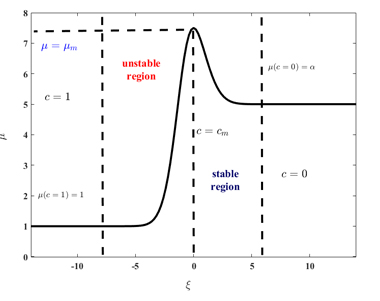
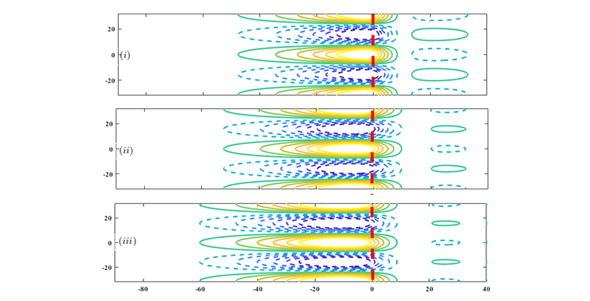
‘The nonmonotonic viscosity profile when a high mobile fluid is displacing a less mobile fluid. There is a potentially unstable region, where the viscosity increases in the flow direction, followed in the downstream direction by a potentially stable region, where the viscosity decreases in the flow direction. The disturbance structure is computed using the singular-value decomposition of the propagator matrix. Reference: Hota & Mishra, Journal of Fluid Mech, Vol. 856, pp:552-579, 2018.’
Dr Tapan is keen on studying other branches of science to provide the correct mathematical approach to address the issues. His project will address one of the hydrodynamic instabilities known as viscous fingering (VF). It forms when a high mobile fluid displaces a low mobile fluid. It has enormous implications in the field of Chemical Engineering Science, Petroleum Engineering, Chromatography, and Oil Extraction process. He explains, “I will study this instability from a mathematician’s point of view, more precisely, to address the mathematical analysis of coupled partial differential equations (PDEs). The system that governs the VF is non-autonomous and there is no readily available stability analysis that can represent Physics, based on robust mathematical analysis. My aim is to connect the dots between mathematics and physics of the VF.”
Infrastructure and laboratory facilities are crucial to conduct research. Upon receiving approval from a prestigious organization like SERB (Science and Engineering Research Board), Govt. of India, Dr. Tapan is entitled to this unique opportunity to serve the scientific community. He divulges, “The award is not only a recognition to me but also to the SRM University, AP. The University will be more visible in the world of research and can attract more eminent scientists and researchers to make the University their second home.” Quoting Master Oogway, ‘Yesterday is history, Tomorrow is a mystery… Today is a gift, that’s why it is called present.’, Dr Tapan is eager to commence working on his project at the earliest, and looks forward to enjoying the process of accomplishing the task.
- Published in Math News, News, Research News
Prof Ajay K Sood, FRS delivered the University Distinguished Lecture 01
Prof A K Sood on “Doing Science Without Borders”: Collaboration and curiosity among researchers will lead to impactful multidisciplinary solutions of the 21st century
 The first University Distinguished Lecture on “Doing Science Without Borders” commenced with an inaugural welcome speech by Prof V S Rao, Vice-Chancellor, and Prof D Narayana Rao, Pro-Vice-Chancellor, SRM University-AP, Andhra Pradesh. Prof V S Rao expressed their gratitude to Prof Ajay K Sood for his gracious presence. Prof Narayana Rao emphasized that under the University Distinguished Lecture series, the talks will be delivered by eminent scientists from India and abroad that would be of immense benefit for students and the faculty and researchers. He further mentioned, “Doctors, researchers, engineers and scientists from several fields of knowledge around the world worked together to confront corona outbreak with an unprecedented spirit of collaboration. Also, NEP advocates and emphasizes that the societal need of the 21st century require broad-based multidisciplinary research and education”.
The first University Distinguished Lecture on “Doing Science Without Borders” commenced with an inaugural welcome speech by Prof V S Rao, Vice-Chancellor, and Prof D Narayana Rao, Pro-Vice-Chancellor, SRM University-AP, Andhra Pradesh. Prof V S Rao expressed their gratitude to Prof Ajay K Sood for his gracious presence. Prof Narayana Rao emphasized that under the University Distinguished Lecture series, the talks will be delivered by eminent scientists from India and abroad that would be of immense benefit for students and the faculty and researchers. He further mentioned, “Doctors, researchers, engineers and scientists from several fields of knowledge around the world worked together to confront corona outbreak with an unprecedented spirit of collaboration. Also, NEP advocates and emphasizes that the societal need of the 21st century require broad-based multidisciplinary research and education”.
Prof Ajay K Sood, Fellow of the Royal Society, FRS and Honorary Professor, Indian Institute of Science (IISc), Bengaluru, narrated three stories of his recent experiments and advanced research work, namely “Emergent flocking behaviour seen in nature: Laboratory experiments”, “Crystallization of Glass: Machine Learning in condensed matter Physics”, and “Bacterial Nano Heat Engine: Getting bacteria to work”. He begins by stating that back in 1944, a profound physicist Schrodinger introduced the concept of “aperiodic crystal” which led to the understanding of genetic molecules, enunciating the importance of inter-disciplinary applications of scientific works. In his first narrative, he speaks of the flocking movement among birds, bacteria, locusts, and human beings as well. He brought the same experiment in his laboratory where he used 2 particles, energized them, and identified their flocking pattern. He observed that the velocity of movement between the two particles differ, which can be applied to particle sorting. This experiment has applications in biology, where bacteria and/or cells can be sorted and separated and also in autonomous cars.
While explaining his second experiment, Prof A K Sood mentioned that he studied the devitrification or the tendency of glass particles to crystallize over time to reach a state of stability from its metastable state. He used supervised Machine Learning to predict where crystallization will occur in glass. His team trained the system to identify the hard and soft particles of the glass. His experiments concluded that Machine Learning (ML) helps in identifying the soft particles, which possess the tendency to move and crystallize over a long period of time. Further, Prof A K Sood and his team of collaborators developed bacterial nano heat engines by mimicking the biological motors in our body which produces energy for living beings to function. Using bacterial activity, they made heat engines and are advancing their research work to recognize the practical applications of the nano heat engines in cars, batteries. The bacteria heat engines is a highly promising technology of the future.
Prof A K Sood narrated his laboratory stories to explicate the splendor of multidisciplinary research which can be used to solve basic problems. He said, “The key to successful scientific research is to collaborate with experts beyond their own domain. Communication and appreciation of views of an open mind enable the scientists to understand the various phenomena. Students and researchers should be curious which will lead to research having various interdisciplinary applications that will make an impact across various domains.”
About thousand participants from IISc,IITs, NITs,IIITs, IISERs, several Indian Universities including University of Hyderabad, Delhi University, NEHU, Pondicherry University, Punjab University; a few foreign Universities including KAUST, Saudi Arabia, Nagoya University, Japan, Zhejiang Ocean University, China, Teesside University, UK, several Engineering Colleges; National Laboratories of DST, DBT, CSIR, ISRO, DRDO, ICMR, BARC, JNCASR, ARIES, ARCI; industries including ARBL, Tata Steel have attended the distinguished lecture given by Prof Ajay Sood.
- Published in Events, News, Research Events, Webinars

